Animals and fantastic places in the museums of Italy: Veneto
The eleventh leg of our journey to discover animals and fantastic places in Italy’s museums takes us to Veneto. Indeed, in the city of the lagoon and other cities in Veneto, one can find dragons, strange creatures, tritons, jellyfish heads and even animals from Chinese mythology. A journey that Finestre Sull’Arte makes in collaboration with the Ministry of Culture to offer an original and fun way to visit museums, suitable for a playful experience with your children and family, remembering that places of culture are safe places and perfect for all ages. So let’s see together which animals and fantastic creatures populate the museums of Veneto!
1. The dragon in Andrea Mantegna ’s San Giorgio at the Gallerie dell’Accademia in Venice.
Already exhausted and defeated on the ground is the dragon that Andrea Mantegna depicted at the foot of Saint George, with the tip of his spear stuck in his jaw. The saint clad in shining armor is in the foreground, proud, having just defeated the monstrous creature that had long been sowing terror among the inhabitants of the Libyan city of Selem. The episode is taken from Jacopo da Varagine’s Legenda Aurea and is one of the best known and most depicted in the history of art as a representation of good overcoming evil. St. George, with a broken spear in his right hand that he holds like a staff and a three-quarter stare, seems to emerge from the faux-marble frame that borders the painting. In an illusionistic effect, the dragon’s snout also seems to protrude from the frame. In the background is the walled city that can be reached by the road marked between the hills. However, the princess saved by the saint does not appear in the work. The painting is now in the Gallerie dell’Accademia in Venice: purchased in 1856, it was part of the Manfrin collection.
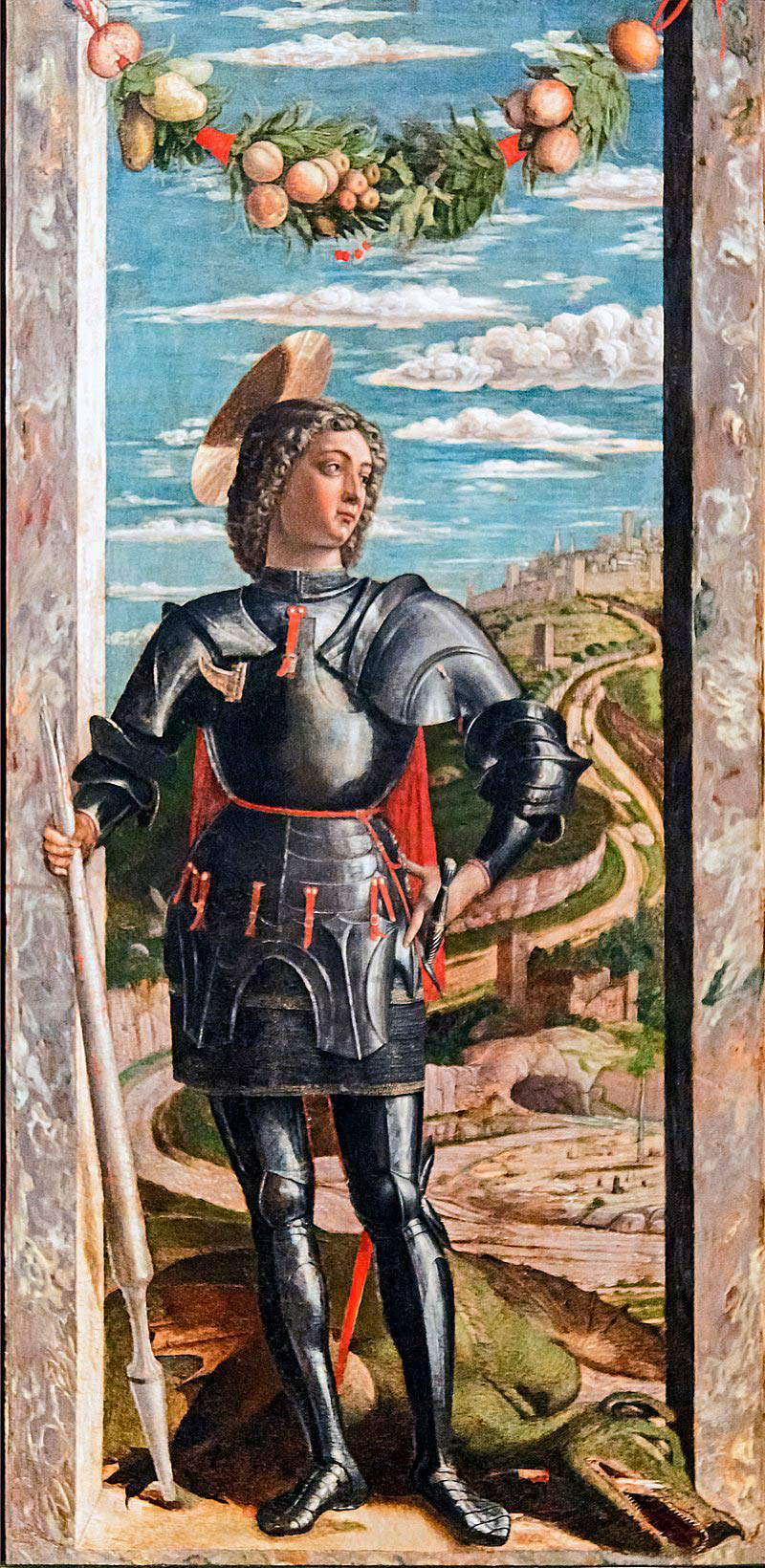
2. Fantastic creatures in Bosch’s paintings at the Gallerie dell’Accademia in Venice.
The Gallerie dell’Accademia in Venice preserves, in room VII on the second floor, the only pictorial evidence of the Flemish artist Hieronymus Bosch in an Italian public collection. According to the account of the scholar and art collector Marcantonio Michiel in 1521, these paintings were part of the refined collection of Cardinal Domenico Grimani, who had gathered them in a sort of “dressing room” among the most important works in his collection. The works are extraordinary visions of the painter, full of hybrid beings born of Bosch’s exceptional imagination. In this room of the Venetian museum is the Triptych of Saint Liberata with the crucified saint in the central panel flanked by her father ordering her martyrdom and her betrothed, the Infernal Vision and Saint Anthony Abbot in the left-hand compartment, and the Sea View in the right-hand compartment; the Four Visions of the Afterlife in which it is possible to recognize Paradise, Hell populated by monsters who capture sinners, Purgatory and a kind of cliff from which souls are plunged to Hell; the Triptych of the Hermits with St. Jerome, St. Anthony and St. Egidius: particularly in the panel on the left, St. Anthony is surrounded by original little monsters that allude to the temptations the saint had to resist.
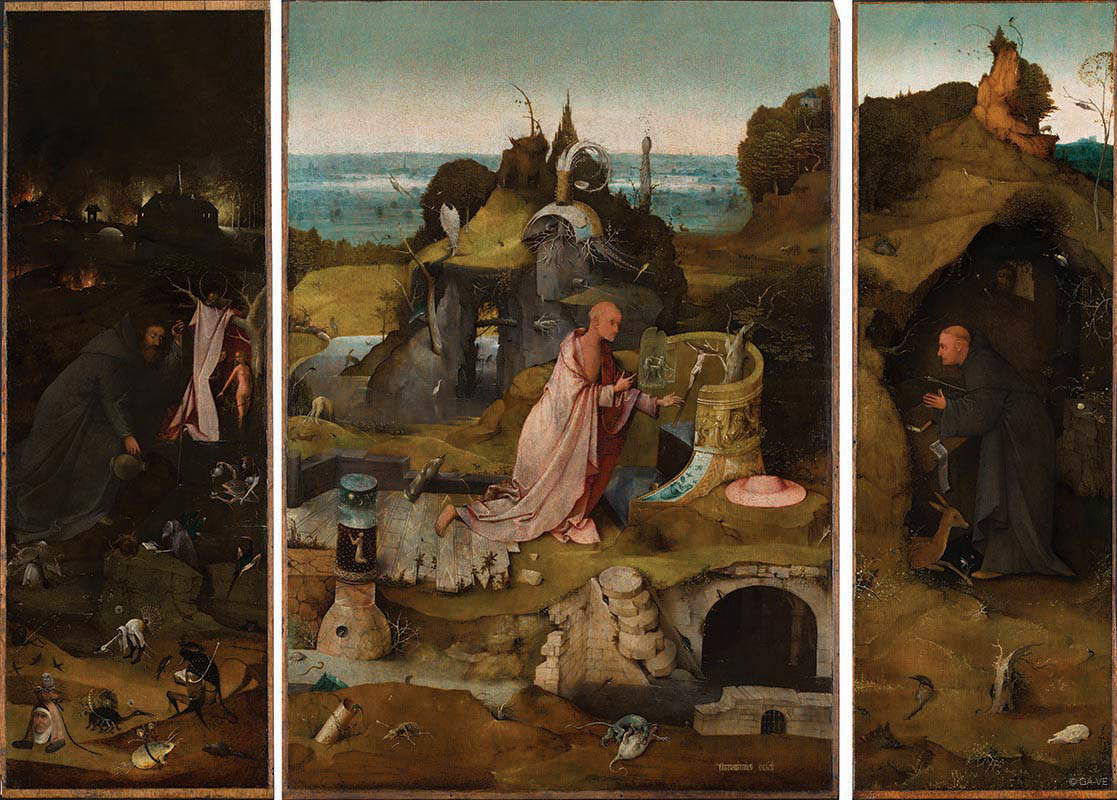
3. The triton in the bronze statue in the Giorgio Franchetti Gallery at the Ca’ d’Oro in Venice.
A bronze statue nearly a foot high preserved at the Giorgio Franchetti Gallery at the Ca’ d’Oro depicts a triton playing a wind instrument. Tritons are descended from Triton, son of the sea god Poseidon and the Nereid Amphitrite, and are creatures drawn from Greek mythology characterized by their dual natures: human from the waist up and fish from the waist down, like the one depicted in the bronze statuette, kneeling on a small plinth. The bronze statuette can be dated between the 16th and 17th centuries and is from a Venetian workshop. With his head in profile, the young triton blows hard into the spiral instrument he holds at the end with his left arm raised in the air, while his right hand rests on one of the two fish tails that touches his side in a sinuous manner. Tritons were generally in the service of sea deities, Poseidon in primis, and had the ability to unleash or quell sea storms.
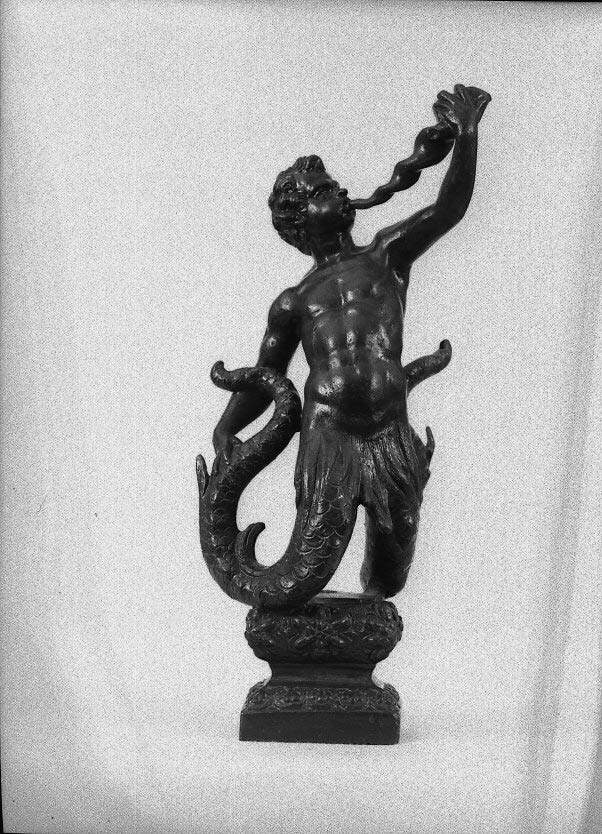
4. Head of Medusa from the Museo Nazionale Atestino
The Museo Nazionale Atestino, an archaeological museum in Este in the province of Padua, holds a bronze sconce in the shape of the head of Medusa, a mythological creature who is considered the most famous of the three Gorgons. Daughter of the sea gods Forco and Ceto, she had snakes for hair and had the power to petrify anyone who looked into her eyes. In fact, the object depicts Medusa’s face with snakes in her windswept hair, a fixed, piercing gaze fit for enchantment, and a half-open mouth. The remarkable bronze ornamental wall sconce dates to the early imperial age, that is, the beginning of the first century AD, and was discovered in 1895 near Monte Murale in Este. It is a very fine object of Hellenistic tradition, probably imported from Magna Graecia.
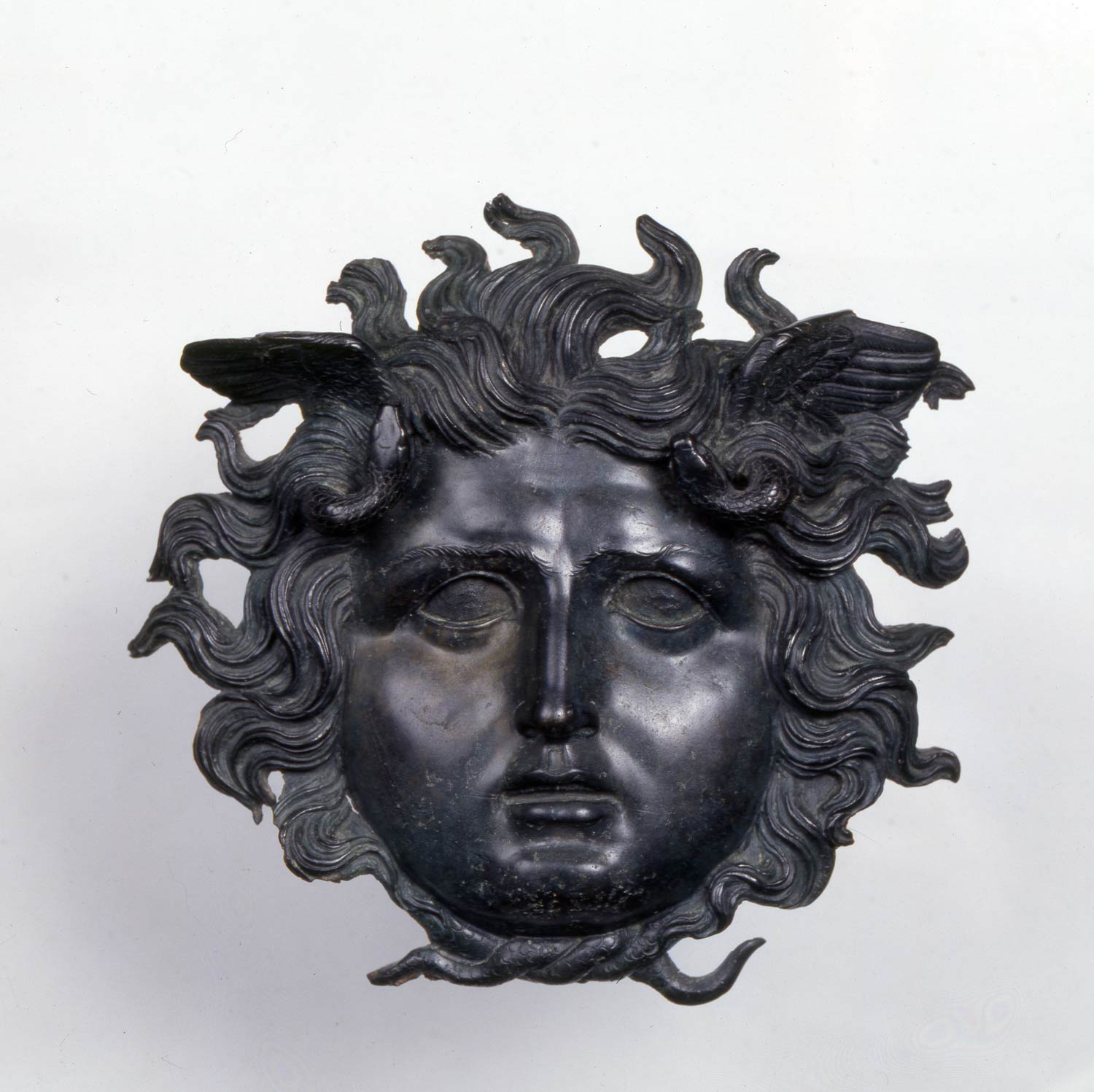
5. The phoenix in the gem from the National Archaeological Museum in Venice.
A fantastic animal carved in a precious stone, precisely in an amethyst gemstone: this is a phoenix, a mythological bird and considered sacred, usually depicted in a fiery red color and large in size, which is able to be reborn from its ashes after three days after its death, which is caused by immolating itself on fire. It is therefore a symbol of death and resurrection, that is, a symbol of rebirth: in fact, the Romans associated the phoenix with the immortality of the Empire. According to Pliny this bird could live up to 660 years, while for Herodotus for 540 years. It is also a symbol of meekness because it does not kill, feeds on dew and does not crush anything it touches. In this precious gem preserved at the National Archaeological Museum in Venice and measuring just over an inch in size, the phoenix is depicted in profile facing left. Of Roman production, the violet-colored carved gemstone can in fact be dated to the first century AD and comes from the San Donato collection in Zadar, Croatia.
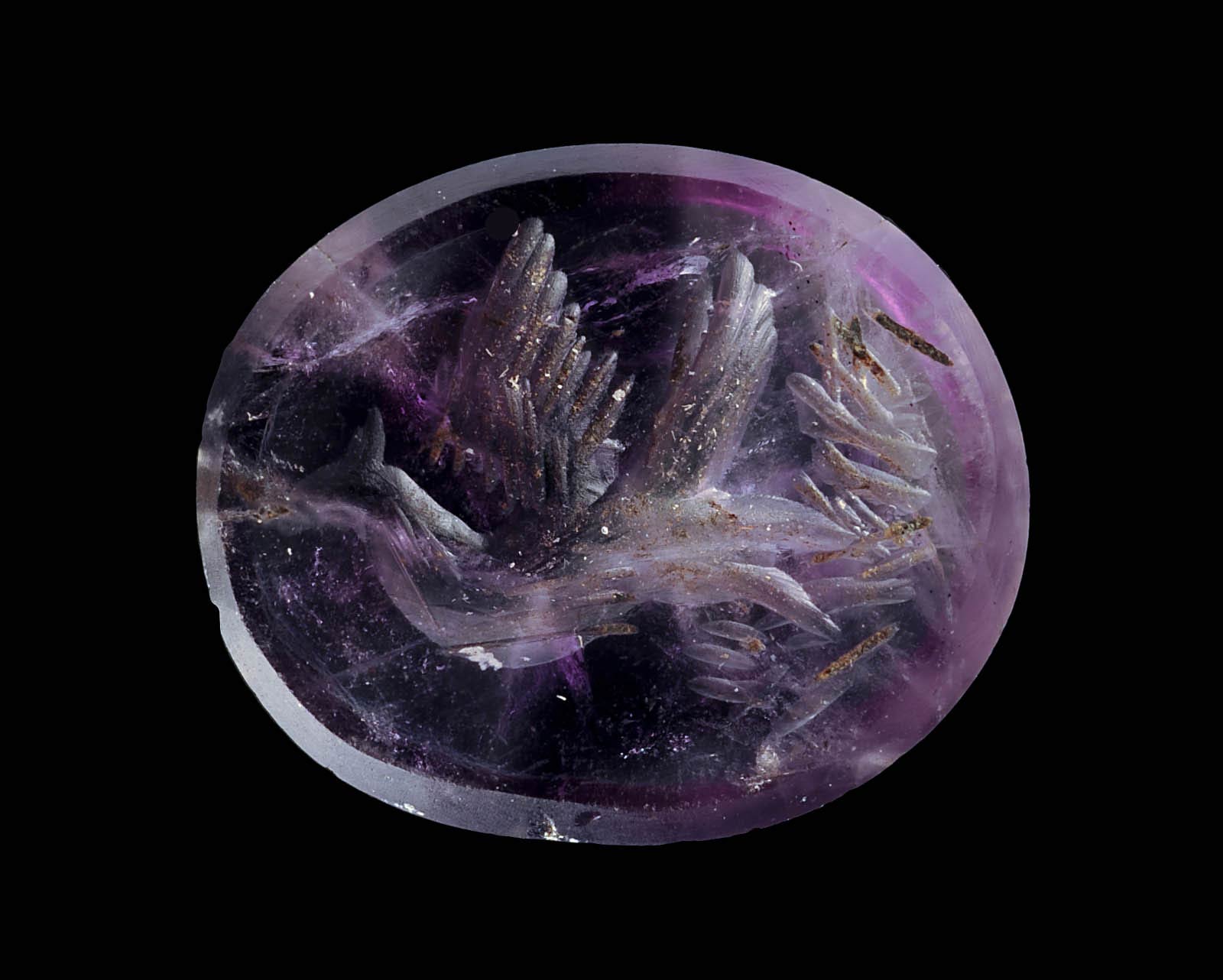
6. The sphinx of the National Museum and Archaeological Area of Altino.
We all know what a sphinx looks like, and the one visible at the National Museum and Archaeological Area of Altino also has a lion’s body and a human head: it is specifically an androsphynx. Made of Aurisina limestone, it constitutes an acroterium, or the decorative element that usually stands at the apex and corners of the pediment of an ancient temple, but in this case it adorned the roof of a funerary monument. The sculpture dates from the first century AD and comes from the Altinate necropolis. Equipped with wings and crouched on its hind legs, it stares enigmatically at the observer. The head with human features is rounded, with a tight mouth and pronounced chin and cheeks; sharply defined also is the hair divided in the center of the head by a line. According to the myth, this creature stood on the road to Thebes and from a high cliff proposed to anyone passing by a riddle of difficult resolution, which only Oedipus was able to solve. Hence it is a symbol of enigma and power.
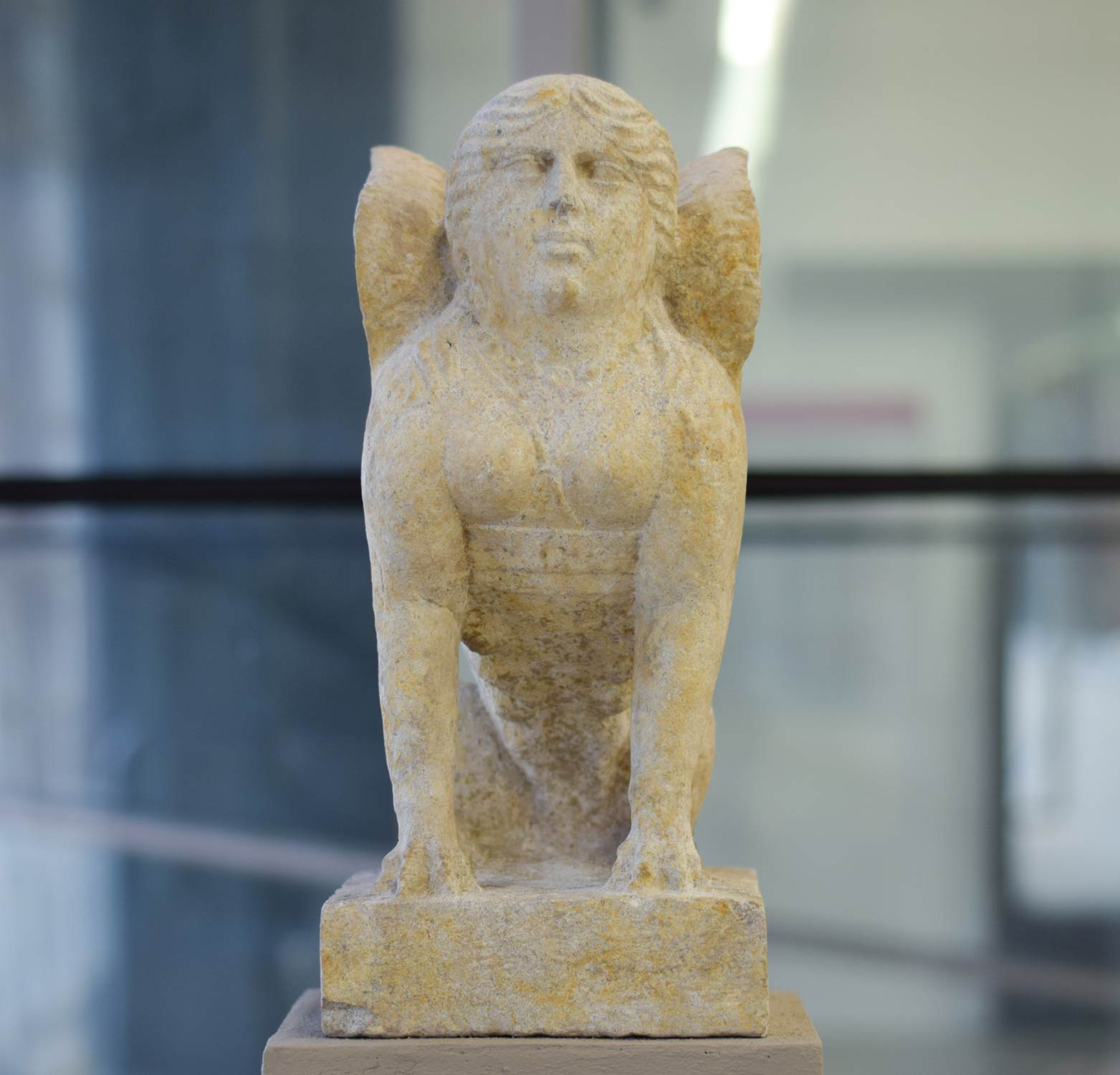
7. Salamander in the high relief in the Psyche Room of the Museum of Palazzo Grimani.
In the spring of 2021 at the Museum of Palazzo Grimani, major restoration and rearrangement works were carried out on the rooms. Among them, the restoration of the Psyche Room led to an unexpected discovery: a carved relief was discovered in a wall cavity, which turned out to be the soft stone backdrop of a fireplace that had been closed for centuries. The subject is the legendary Salamander in the flames. In mythology, the salamander, likened to the amphibians of the same name, was considered a creature of fire: in fact, it was thought to be able to live among flames, managing to pass through them while remaining unharmed. In his Natural History (77-78 AD) Pliny the Elder stated that “the salamander is so cold that on its contact fire is extinguished not unlike the effect produced by ice.” This creature is linked to numerous symbolic meanings, such as constancy, resistance to evil and enemies, and military valor.
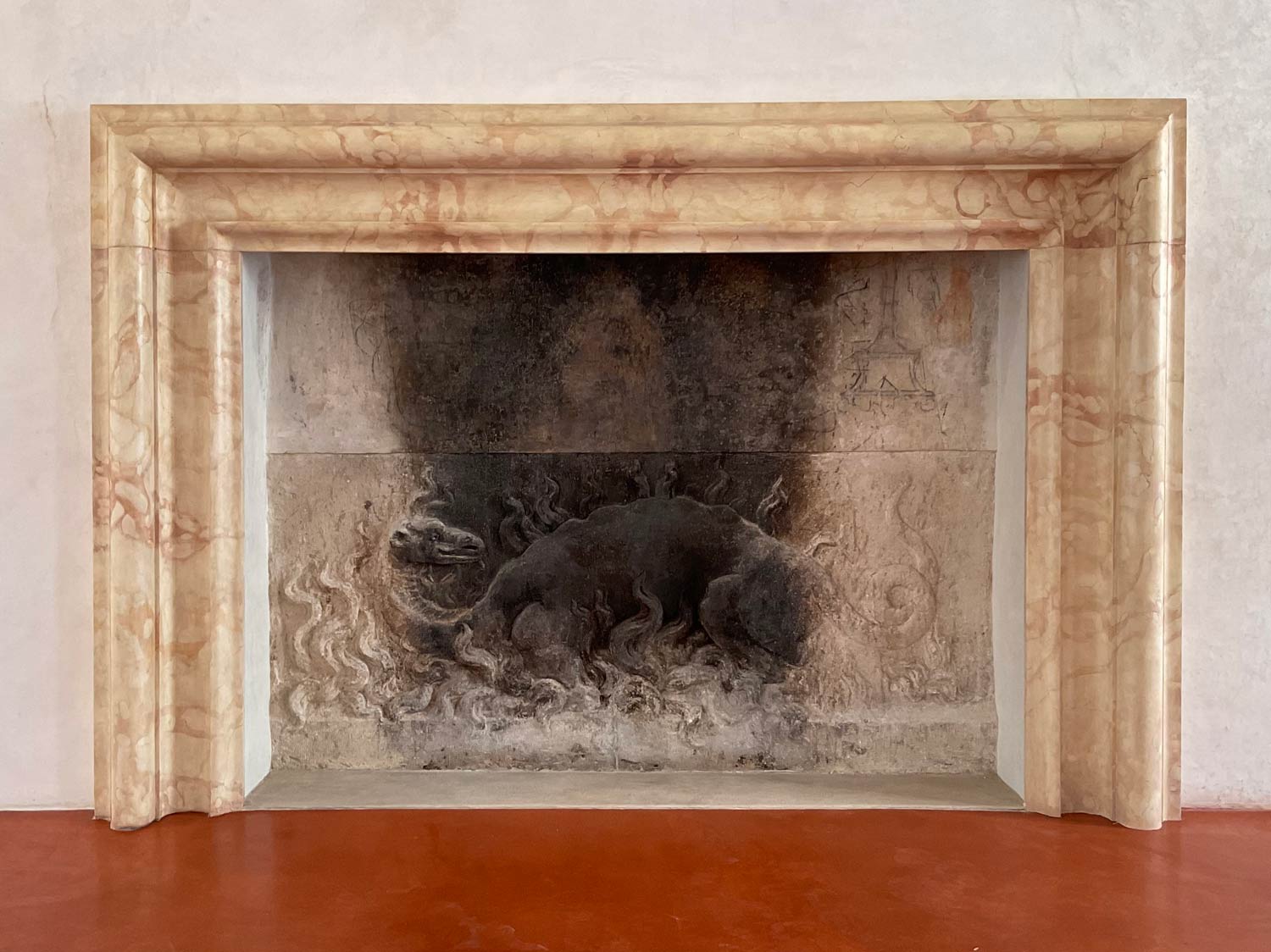
8. The satyrs of the Hall of the Triumph of Bacchus in the National Museum of Villa Pisani
Among the first rooms on the main floor of the National Museum of Villa Pisani is the one dedicated to the Triumph of Bacchus, a celebration of the god of wine and music. The eighteenth-century room, among the most striking, is decorated by frescoes by Jacopo Guarana, a pupil of Tiepolo, executed around 1770: these are works that tell the stories of Bacchus. In Bacchanal, the figures depicted stand on a meadow and delight in dancing, such as the two half-naked maidens jumping and playing tambourines, and in feasting. On the left is depicted a satyr, a fantastic creature with a dual nature: human from the waist up and equine from the waist down. Also in the Procession of Silenus, depicted astride an elephant, the characters are immersed in a landscape, and the elephant itself presents a peculiarity: the legs do not correspond to the real thing, but testify to the way animals are depicted in bestiaries.
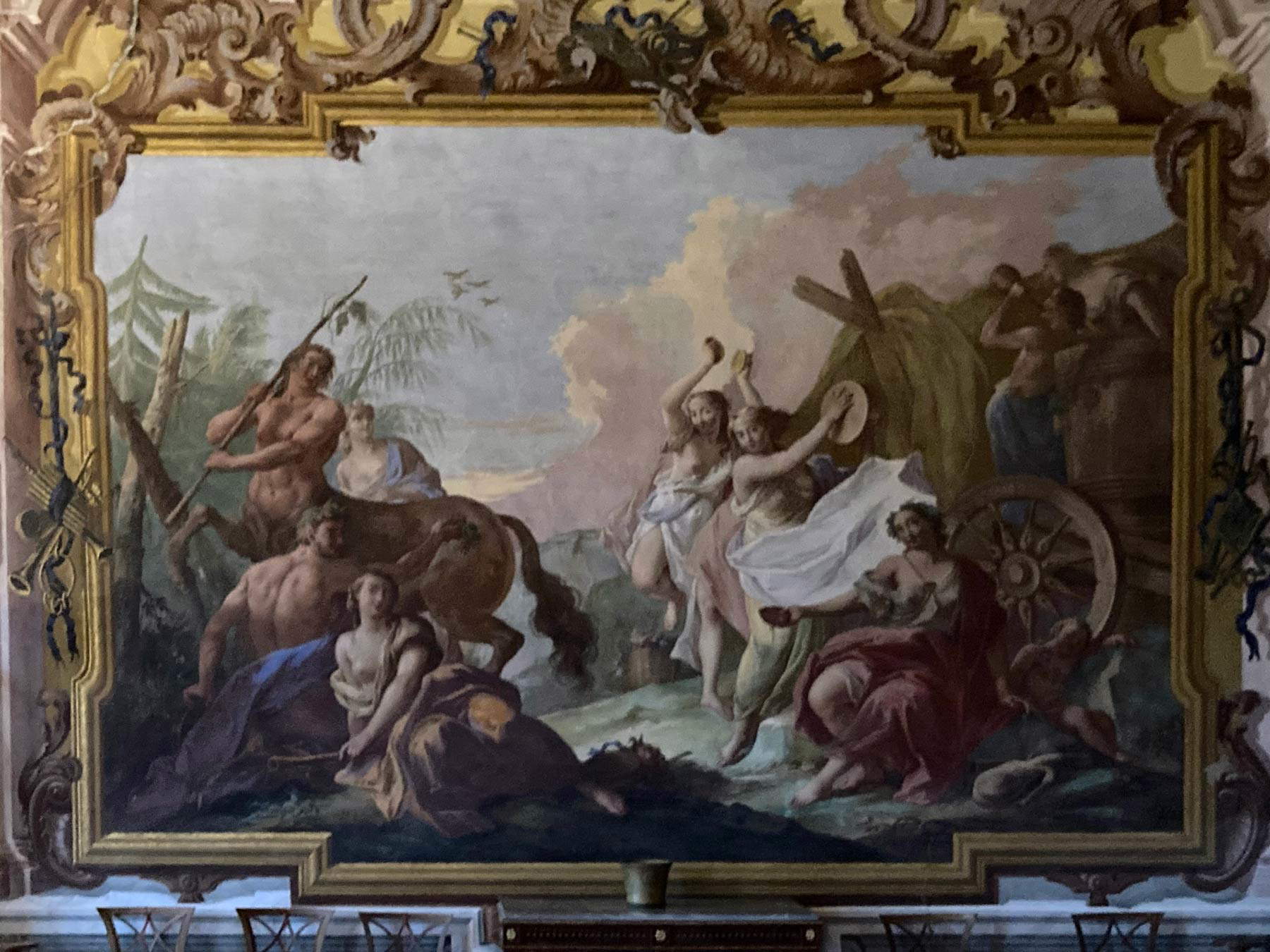
9. The Kirin of the Museum of Oriental Art in Venice.
The Museum of Oriental Art in Venice holds a large collection of fantastic animals related to the Chinese and Japanese worlds: there are Chinese lions, dragons, the Chokaro magic horse that refers to the legend of Chokaro sennin, an immortal being who possesses a horse that can emerge as if by magic from a gourd. And then the Kirin or Qilin, a creature from Eastern mythology, also called the Chinese unicorn. Along with the dragon, phoenix and turtle, it is one of the four animals of good luck. It has a gentle disposition and its appearance heralds a happy event or is a sign of good governance or the coming of a wise man. According to legend, the kirin appeared during the happy reign of rulers Yao and Shun and at the time of Confucius’ birth. The object in the collection of the Museum of Oriental Art is a Japanese blue and white porcelain perfume burner dating from the Edo period.
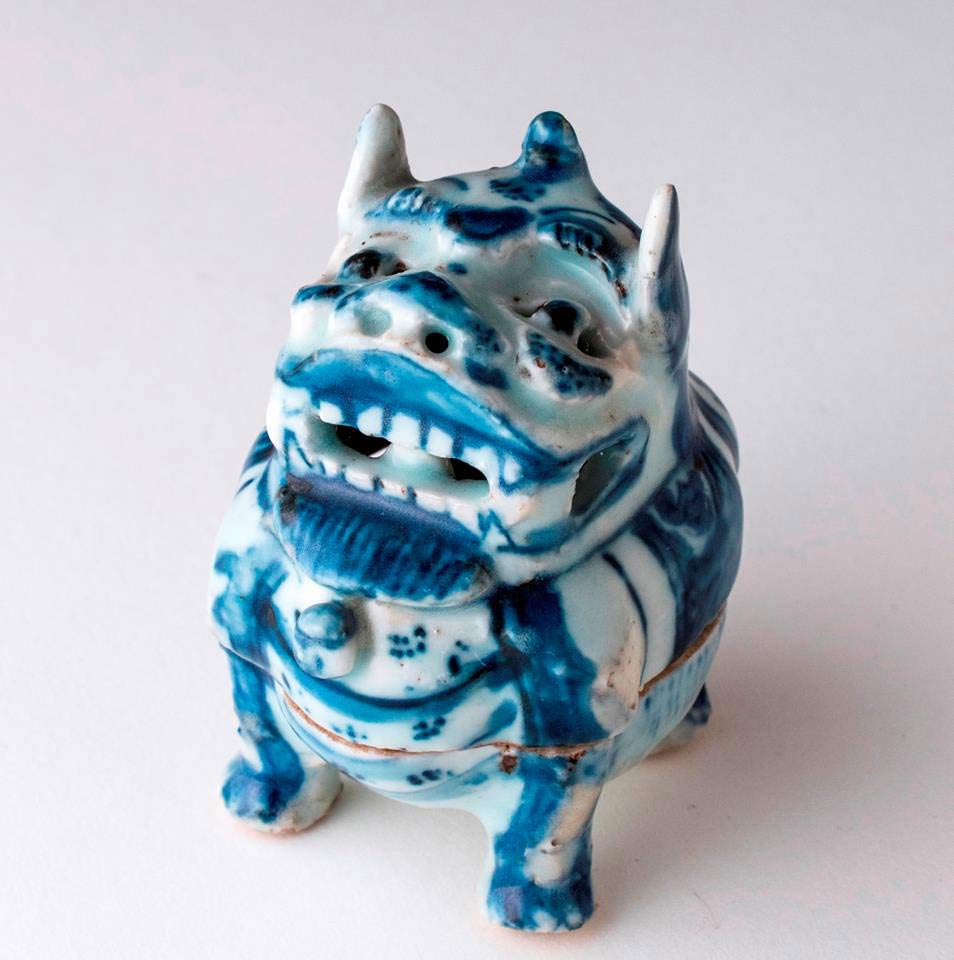
10. The griffon vulture at the National Archaeological Museum in Portogruaro.
The National Archaeological Museum in Portogruaro also has a large collection of fantastic animals, including sea monsters, dragons, tritons, sphinxes and other creatures. A limestone lintel depicts a griffin in profile resting a paw on a vase. It can be dated to the first century AD. The griffin is a fantastic winged animal that has the body of a lion and the head of an eagle. The most frequent depiction of this creature is found in Minoan/Mycenaean and Greek art; indeed, it appears to be an ancient Greek vase that the winged animal rests its right front paw on. It is a symbol of guardianship and wisdom, but also of perfection and power.
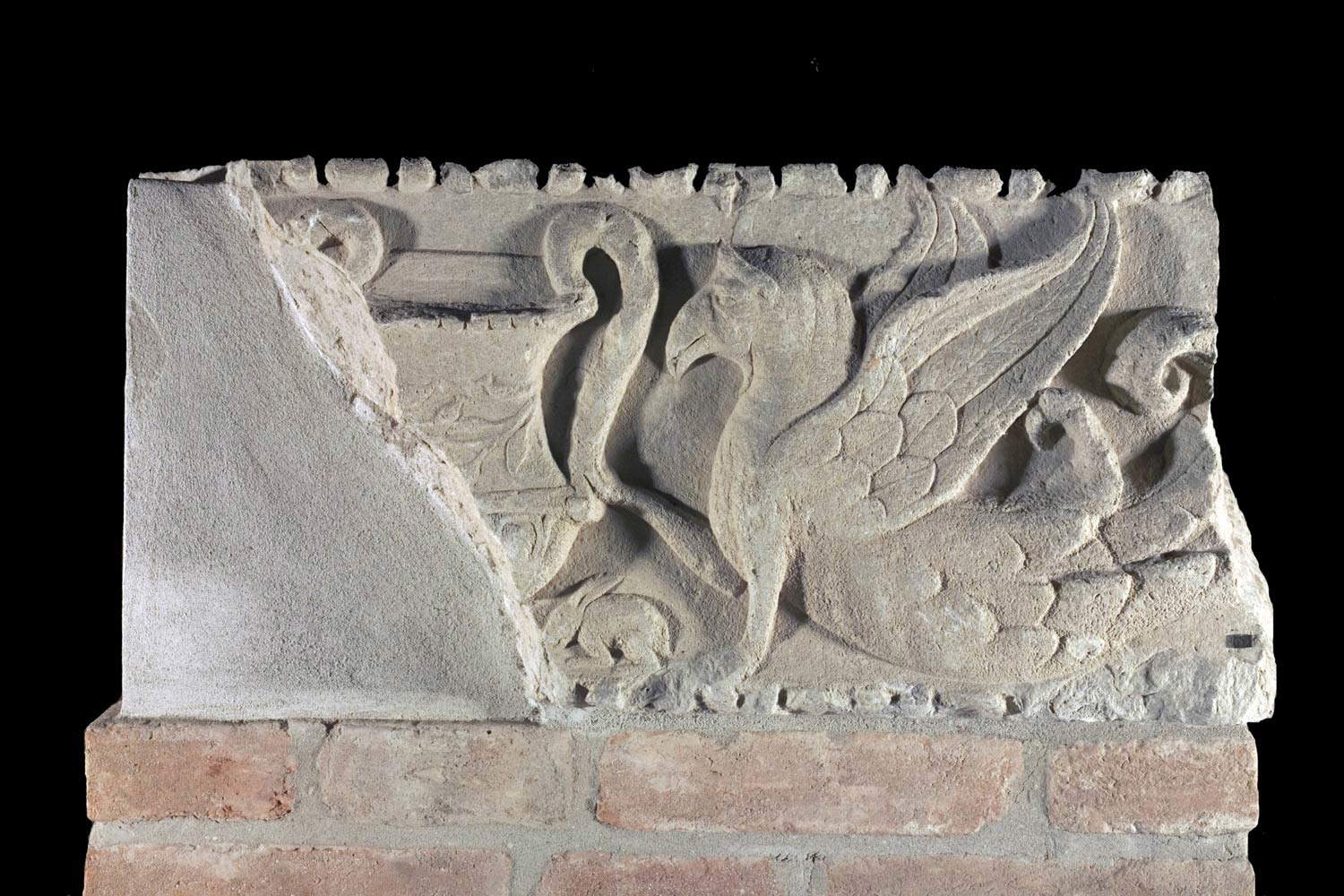
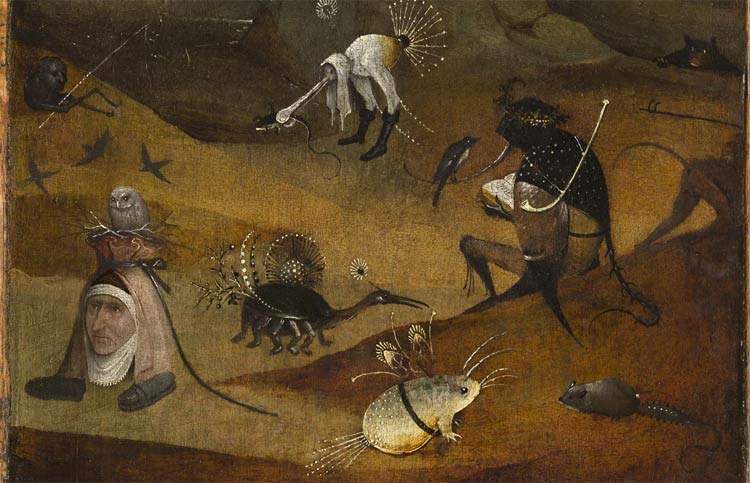 |
| Animals and fantastic places in the museums of Italy: Veneto |
Warning: the translation into English of the original Italian article was created using automatic tools. We undertake to review all articles, but we do not guarantee the total absence of inaccuracies in the translation due to the program. You can find the original by clicking on the ITA button. If you find any mistake,please contact us.



























